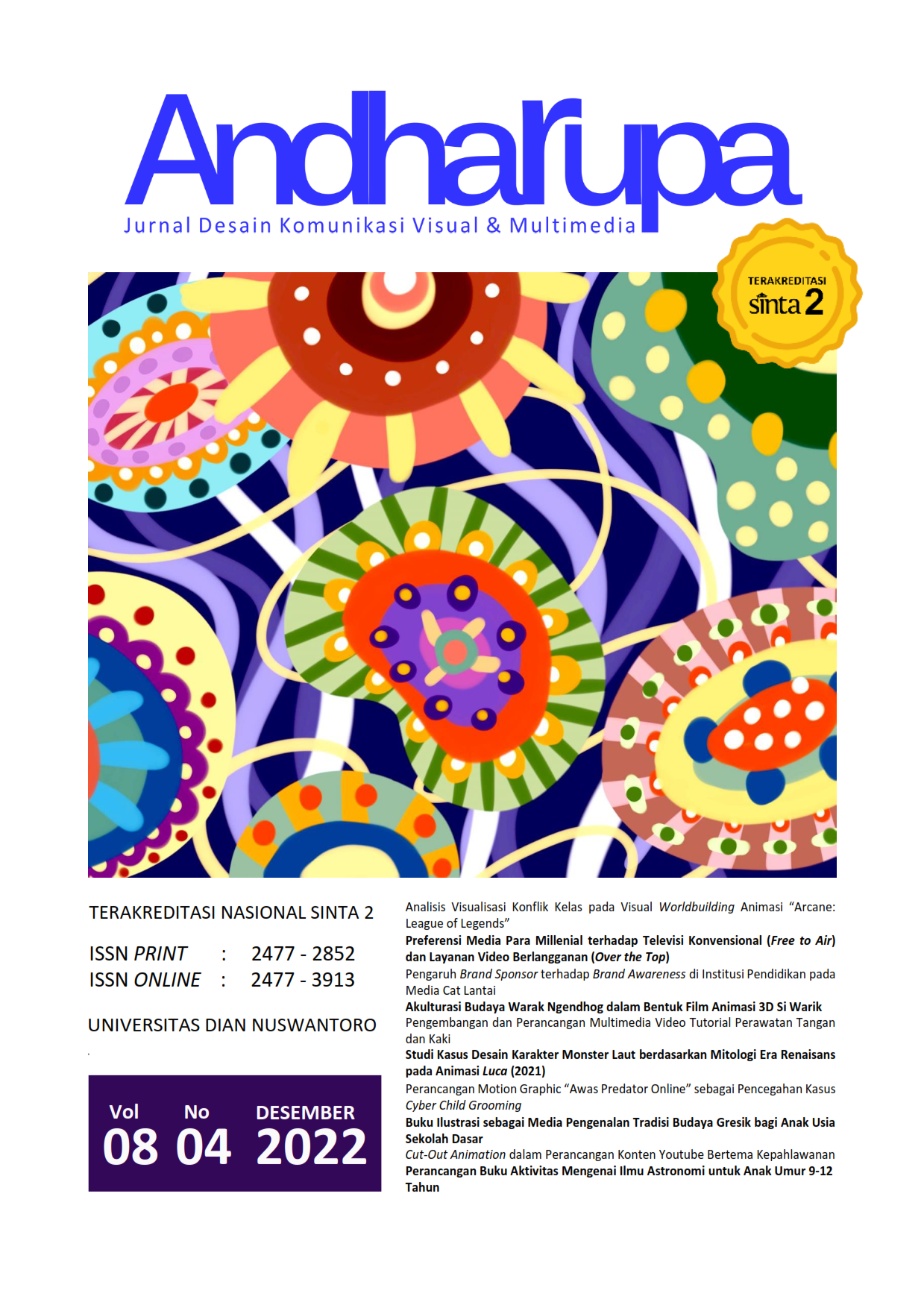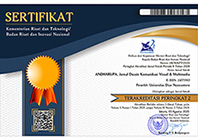Analisis Visualisasi Konflik Kelas pada Visual Worldbuilding Animasi “Arcane: League of Legends”
DOI:
https://doi.org/10.33633/andharupa.v8i04.6214Abstract
AbstrakAnimasi “Arcane: League of Legends” merupakan hasil turunan media dari dunia game “League of Legends”. Namun Worldbuilding dikemas Arcane dengan cerdik dan alami sehingga bagi penonton yang bukan pemain atau belum mengetahui game “League of Legends” masih dapat menikmati animasi tersebut tanpa harus mencari penjelasan cerita dalam game terlebih dahulu. Artikel ini bertujuan untuk mengidentifikasi apa saja komponen atau setting Worldbuilding yang terdapat pada visual animasi tersebut, dan bagaimana storytelling atau narasi terkait konflik kelas disampaikan secara visual ke dalam komponen Worldbuilding tersebut. Metode penelitian untuk animasi menggunakan pendekatan deskriptif kualitatif dengan metode critical visual analysis serta memanfaatkan teori elemen Worldbuilding milik Kevin J. Anderson untuk menganalisa dan mengelompokkan komponen visual Worldbuilding yang didapat. Studi ini memberikan gambaran mengenai penerapan Worldbuilding ke dalam visual animasi, seperti persebaran unsur Worldbuilding dalam visual animasi, unsur Worldbuilding yang paling efektif disampaikan melalui visual animasi ini, serta hasil narasi yang didapat dari visual unsur Worldbuilding dalam animasi. Kata Kunci: animasi, arcane, konflik kelas, Worldbuilding Abstract"Arcane: League of Legends" animation is one of the derivative product from the "League of Legends" game universe, but the animation team were able to deliver the Worldbuilding in a clever and natural way so that viewers who are not players or don't know the game "League of Legends" can still enjoy the animation without have to find the game lore first. This article aims to identify what components or Worldbuilding settings are contained in the animation visuals, and how storytelling or narratives related to class conflicts are visually conveyed into the Worldbuilding components. The research method for animation uses a qualitative descriptive approach with critical visual analysis method and utilizes Kevin J. Anderson's theory of Worldbuilding elements to analyze and classify the obtained visual components of Worldbuilding. This study provides an overview of the application of Worldbuilding into visual animation, such as the distribution of Worldbuilding elements in animation visuals, the most effective Worldbuilding elements conveyed through this animated visual, as well as narrative results obtained from visual Worldbuilding elements in animation. Keywords: animation, arcane, class warfare, WorldbuildingReferences
Anderson, Kevin J. (2015). Worldbuilding: From Small Towns to Entire Universes. Colorado: WordFire Press.
Bernardo, Anna. (2022). Netflix's League of Legends: Arcane bags 9 Annie Awards. Retrieved February 8, 2022, from https://ph.news.yahoo.com/netflix-league-of-legends-arcane-annie-awards-042215796.html
Ekman, Stefan, dkk. (2016). Notes Toward a Critical Approach to Worlds and World-Building. Fafnir-Nordic Journal of Science Fiction and Fantasy Research journal.finfar.org
Haryadi, T., Senoprabowo, A., & Sulistiyawati, P. (2021). Analisis Perubahan Trend Iklan Gojek Versi Video Animasi Dalam Sudut Pandang Media Dependency. Amarasi: Jurnal Desain Komunikasi Visual, 2(01), 16-27.
Hayes, Adam. (2022). Conflict Theory. Retrieved May 2, 2022, from https://www.investopedia.com/terms/c/conflict-theory.asp
Rivera, Joshua. (2021). Arcane is great TV even if you don’t care about League of Legends. Retrieved February 8, 2022, from https://www.polygon.com/reviews/22800666/arcane-season-1-review
Selby, A. (2013). Animation. Laurence King Publishing.
Senoprabowo, A., Muqoddas, A., & Hasyim, N. (2022). Memperkenalkan Sejarah dan Nilai-Nilai Perayaan Grebeg Besar Demak melaui Perancangan Game Edukasi. Jurnal Desain, 9(2), 275-296.
Wolf, M. J. (2014). Building Imaginary Worlds: The Theory and History of Subcreation. Routledge.
Zaidi, Leah. (2018). Science Fiction and Transition Design. Toronto: OCAD University.
Downloads
Published
Issue
Section
License
Authors who publish with this journal agree to the following terms:
- Authors retain copyright and grant the journal right of first publication with the work simultaneously licensed under a Creative Commons Attribution License that allows others to share the work with an acknowledgment of the work's authorship and initial publication in this journal.
- Authors are able to enter into separate, additional contractual arrangements for the non-exclusive distribution of the journal's published version of the work (e.g., post it to an institutional repository or publish it in a book), with an acknowledgment of its initial publication in this journal.
- Authors are permitted and encouraged to post their work online (e.g., in institutional repositories or on their website) prior to and during the submission process, as it can lead to productive exchanges, as well as earlier and greater citation of published work (See The Effect of Open Access).















